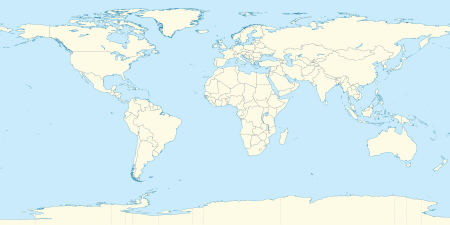FTSE Global Equity Index Series
The FTSE Global Equity Index Series is a series of stock market indices provided by FTSE Group. It was launched in September 2003, and provides coverage of over 17,000 stocks in 48 countries, covering 98% of the world's investable market capitalization.[1]

The series comprises various global and local indices, including:[2]
- FTSE Global Total Cap Index, a global index covering approximately 17,000 stocks from micro cap to large cap
- FTSE Global All Cap Index, a global index covering approximately 9,000 stocks from small cap to large cap
- FTSE All-World Index, a global index covering approximately 4,000 mid cap and large cap stocks
Several of the indices in the series are used by The Vanguard Group as bases of their mutual funds and ETFs.
Overview of indices
[edit]These are some of the most important indices managed by FTSE:
| Size (market cap) of companies included |
Markets included | ||
|---|---|---|---|
| Global | Developed | Emerging | |
| Large, medium, small and micro cap | FTSE Global Total Cap | FTSE Developed Total Cap | FTSE Emerging Total Cap |
| Large, medium and small cap | FTSE Global All Cap | FTSE Developed All Cap | FTSE Emerging All Cap |
| Large and medium cap | FTSE All-World | FTSE Developed World | FTSE Emerging Markets |
FTSE All-World Index
[edit]The FTSE All-World index started in 1986 as the FT-Actuaries World Index.[3]
The All-World series is sub-divided into three segments:
- Developed
- Advanced Emerging
- Emerging Markets
The Base Date is 31 December, 1986.
History
[edit]This index has been calculated since 31 December 1986, originally as the FT-Actuaries World Indices.[4]
In 1995, Wood Mackenzie and Co., one of the original partners, sold its stake to Standard & Poor’s. The name of the index was changed to FT/S&P – Actuaries World Indices.
On 29 November 1999, FTSE International Limited acquired the stakes of Goldman Sachs and Standard & Poor’s. The name changed to the FTSE World Index series.
FTSE took exclusive rights to integrate the Baring Emerging Markets data series with its existing FTSE World Index series. This resulted in the creation of the FTSE All-World Index series on 30 June, 2000.[5]
On 22 September, 2003, FTSE introduced enhancements to improve the coverage of mid cap stocks in the index and remove some smaller stocks.
Countries/Regions
[edit]The FTSE All-World Index includes companies in the following countries/regions:[6]
- Australia
- Austria
- Belgium
- Brazil
- Canada
- Chile
- China
- Colombia
- Czech Rep.
- Denmark
- Egypt
- Finland
- France
- Germany
- Greece
- Hong Kong
- Hungary
- Iceland
- India
- Indonesia
- Ireland
- Israel
- Italy
- Japan
- Korea
- Kuwait
- Malaysia
- Mexico
- Netherlands
- New Zealand
- Norway
- Pakistan
- Philippines
- Poland
- Portugal
- Qatar
- Romania
- Saudi Arabia
- Singapore
- South Africa
- Spain
- Sweden
- Switzerland
- Taiwan
- Thailand
- Turkey
- UAE
- UK
- USA
Total annual returns
[edit]| Year |
FTSE All-World |
FTSE Developed |
FTSE Emerging |
|---|---|---|---|
| 2012 | 17.1 | 17.0 | 17.9 |
| 2013 | 23.3 | 26.8 | -3.5 |
| 2014 | 4.8 | 5.1 | 1.6 |
| 2015 | -1.7 | -0.3 | -15.2 |
| 2016 | 8.6 | 8.2 | 13.5 |
| 2017 | 24.6 | 23.9 | 32.5 |
| 2018 | -9.1 | -8.6 | -13.0 |
| 2019 | 27.2 | 28.0 | 20.6 |
| 2020 | 16.6 | 16.7 | 15.5 |
| 2021 | 18.9 | 21.4 | 0.1 |
| 2022 | -17.7 | -17.8 | -16.9 |
| 2023 | 22.6 | 24.2 | 9.1 |
Sector representation
[edit]The ICB breakdown is shown here, with technology being the biggest sector.
Top 10 Constituents by index weight
[edit]| Constituent | Weight (%) |
|---|---|
| Microsoft Corp | 4.33 |
| Apple Inc. | 3.75 |
| NVIDIA | 2.64 |
| Amazon.com Inc | 2.24 |
| Facebook Inc A | 1.52 |
| Alphabet Inc A | 1.16 |
| Alphabet Inc C | 0.99 |
| Eli Lilly and Co | 0.90 |
| Broadcom Inc | 0.79 |
| Tesla | 0.78 |
See also
[edit]References
[edit]- ^ "FTSE Global Equity Index Series (GEIS)". FTSE Russell.
- ^ "FTSE GEIS product highlights" (PDF). FTSE Russell.
- ^ "FTSE All-World Index Factsheet". FTSE Russell. October 20, 2017.
- ^ "Documents - FTSE indices". Institute and Faculty of Actuaries. September 1, 2004.
- ^ "Indexing the world" (PDF). FTSE Russel.
- ^ "Factsheet FTSE All-World-Index". Retrieved 31 December 2022.
- ^ "FTSE Russell Factsheets". Retrieved 31 December 2022.
